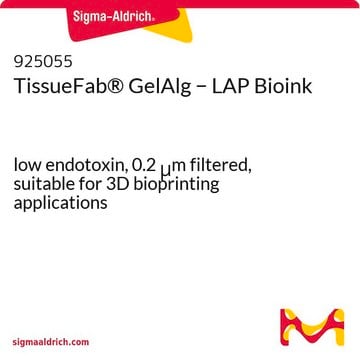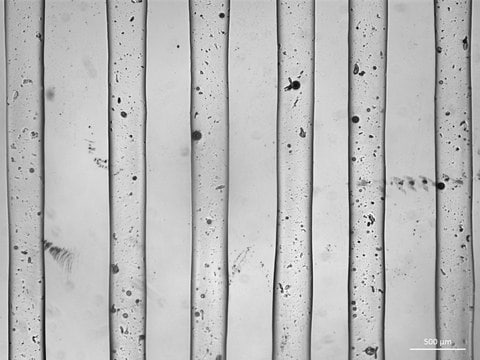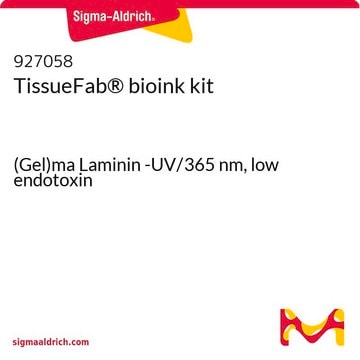926159
TissueFab® bioink Alg(Gel)ma -UV/365 nm
Synonym(e):
GelMA-alginate bioink
About This Item
Empfohlene Produkte
Form
viscous liquid (gel)
Qualitätsniveau
Verunreinigungen
<5 CFU/g Bioburden (Total Aerobic)
<5 CFU/g Bioburden (fungal)
<50 EU/mL Endotoxin
Farbe
pale yellow to colorless
pH-Wert
6.5-7.5
Viskosität
10-40 cP(37 °C)
Anwendung(en)
3D bioprinting
Lagertemp.
2-8°C
Verwandte Kategorien
Allgemeine Beschreibung
Alginate is a naturally occurring polymer widely applied for bioprinting applications as its printability can be easily modified by altering the polymer density and crosslinking with the addition of calcium chloride (CaCl2). Alginate is often combined with gelatin to facilitate cell adhesion and differentiation.
Temporal and spatial control of the crosslinking reaction can be obtained by adjusting the degree of functionalization and polymerization conditions, allowing for the fabrication of hydrogels with unique patterns, 3D structures, and morphologies.
Anwendung
- osteogenic ,
- chondrogenic ,
- hepatic ,
- adipogenic ,
- vasculogenic ,
- epithelial ,
- endothelial ,
- cardiac valve ,
- skin ,
- tumors
Leistungsmerkmale und Vorteile
- Ready-to-use formulation optimized for high printing fidelity and cell viability, eliminating the lengthy bioink formulation development process
- Step-by-step protocols developed and tested by MilliporeSigma 3D Bioprinting Scientists, no prior 3D bioprinting experience needed
- Suitable for different extrusion-based 3D bioprinter model
- Methacrylamide functional group can also be used to control the hydrogel physical parameters such as pore size, degradation rate, and swell ratio.
Rechtliche Hinweise
Lagerklassenschlüssel
10 - Combustible liquids
WGK
WGK 3
Flammpunkt (°F)
Not applicable
Flammpunkt (°C)
Not applicable
Analysenzertifikate (COA)
Suchen Sie nach Analysenzertifikate (COA), indem Sie die Lot-/Chargennummer des Produkts eingeben. Lot- und Chargennummern sind auf dem Produktetikett hinter den Wörtern ‘Lot’ oder ‘Batch’ (Lot oder Charge) zu finden.
Besitzen Sie dieses Produkt bereits?
In der Dokumentenbibliothek finden Sie die Dokumentation zu den Produkten, die Sie kürzlich erworben haben.
Unser Team von Wissenschaftlern verfügt über Erfahrung in allen Forschungsbereichen einschließlich Life Science, Materialwissenschaften, chemischer Synthese, Chromatographie, Analytik und vielen mehr..
Setzen Sie sich mit dem technischen Dienst in Verbindung.








